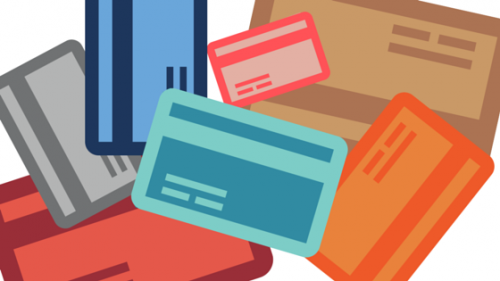Credit & Debt

How to Establish or Improve Credit
- Pay all your bills on time
- Take advantage of layaway, and 90-day no interest plans
- If you have steady income, get a limited-use credit card, or a credit card with a low limit
- Open and use a checking account to show you can handle your money responsibly
- Open a savings account
- Review your credit report every year - www.annualcreditreport.com
Types of Credit
- Installment loan - These loans are set for a fixed amount and must be paid over a set period of time using a fixed monthly amount. Examples: car loans, personal loans and mortgages.
- Revolving credit - This allows you to borrow up to a set amount called a credit limit. As payments are made and more purchases are made, the balance will revolve, with old debt being replaced by new. Credit cards are the most common revolving credit.
- Service credit - This type of credit allows you to receive a service before you pay. You pay the amount of service you use monthly (and in some situations, quarterly). Examples: utility bills and medical bills.
- It’s also important to know the facts on student loans and the heavy debt they can come with.
- Understand the difference between debit cards and credit cards with this helpful fact sheet.
What If I Have Problems Paying Bills?
- Use this sample letter to request a payment arrangement
- Consider credit counseling
- Use a repayment calculator to help organize yourself
- After all other resources have been used, research your bankruptcy options
Signs of Credit Card Trouble
- Making only the minimum payment each month
- Taking out new loans to pay off old ones or using one credit card to pay off another
- Skipping payments
- Past-due notices coming in the mail often
- Dipping into savings to pay bills
- You’re not sure how much you owe
- Credit payments (minus home mortgage) are taking more than 20 percent of your take-home pay
- Reliance on extra income to make monthly payments, i.e. overtime, moonlighting, etc.
- You’re denied credit
- You’ve got a dangerous debt ratio - this Debt Ratio Worksheet can help you find your ratio
Keeping Track of Your Credit
It’s a good idea to request a copy of your credit report at three different times during a 12 month period. For example, you can request a copy from TransUnion in January, a copy from Equifax in May, and a copy from Experian in September.
Credit Score
Your credit score doesn’t come with your free credit reports - If you want your official credit score, then you will need to purchase it. Remember that your score is a benchmark that’s constantly changing, so it’s much better for you to work on your credit report and the score will follow. To purchase a credit score, you can visit: myFICO.com or vantagescore.com
What influences your credit score?
Credit scores are compiled from the information located in your credit reports (for example, Experian, Equifax and TransUnion). This number predicts how much of a credit risk you are for potential creditors and lenders.
The following information is for educational purposes only and highlights how a FICO Credit Score is calculated. This information is retrieved from Experian.
- Payment history. Payment information on credit cards, installment loans (such as a car loan), mortgage loans or finance company accounts. Are there public record items, such as judgments or bankruptcy, and collection items? Details on late or missed payments, including how much was owed, how late the payments were and how recently they occurred. How many accounts show no late payments. According to Fair Isaac, this category usually determines about 35 percent of your score.
- Outstanding debt. Amount owed on all accounts and on different types of accounts, such as credit cards or installment loans. How many accounts have balances? How close are you to each credit limit? According to Fair Isaac, this category usually determines about 30 percent of your score.
- Credit history. How long have you been building a credit history? How long specific accounts have been established and how long since you used each account? According to Fair Isaac, this category usually determines about 15 percent of your score.
- Pursuit of new credit. How many inquiries and new accounts does your report show, and how recent are they? How long has it been since the most recent inquiry? Whether you have made on-time payments to re-build your credit after a period of frequent late payments. According to Fair Isaac, this category usually determines about 10 percent of your score.
- Types of credit in use. How many accounts are reported for bank cards, travel and entertainment cards, department store cards, installment loans, and so on. According to Fair Isaac, this category usually determines about 10 percent of your score.
When lenders request your credit score, they also receive a list of the four most significant reasons your score is not higher. Although lenders do not have to tell you your score, they should share the reasons listed on the report with you.
Keep in mind that your credit report changes day to day as you make payments or increase balances. If you pay off your credit cards in full every month but your credit score is compiled before your payments are reported to the credit bureau, your score will reflect those balances. Generally, the total balance on your last statement is the amount shown on your credit report.



 Print
Print Email
Email